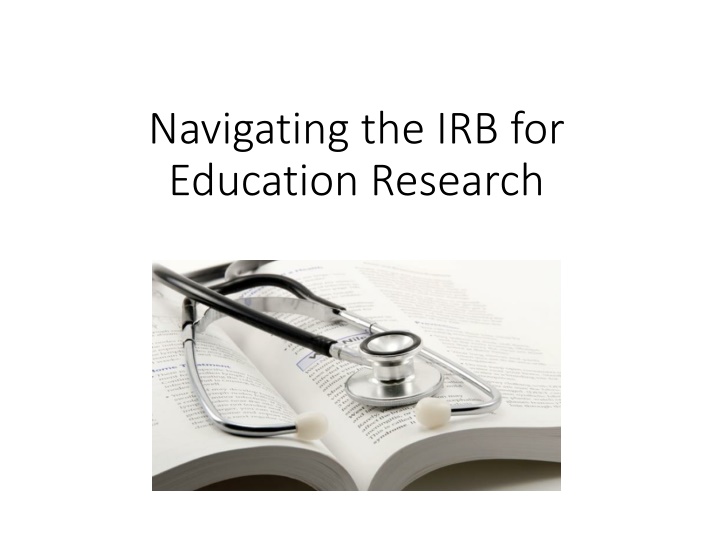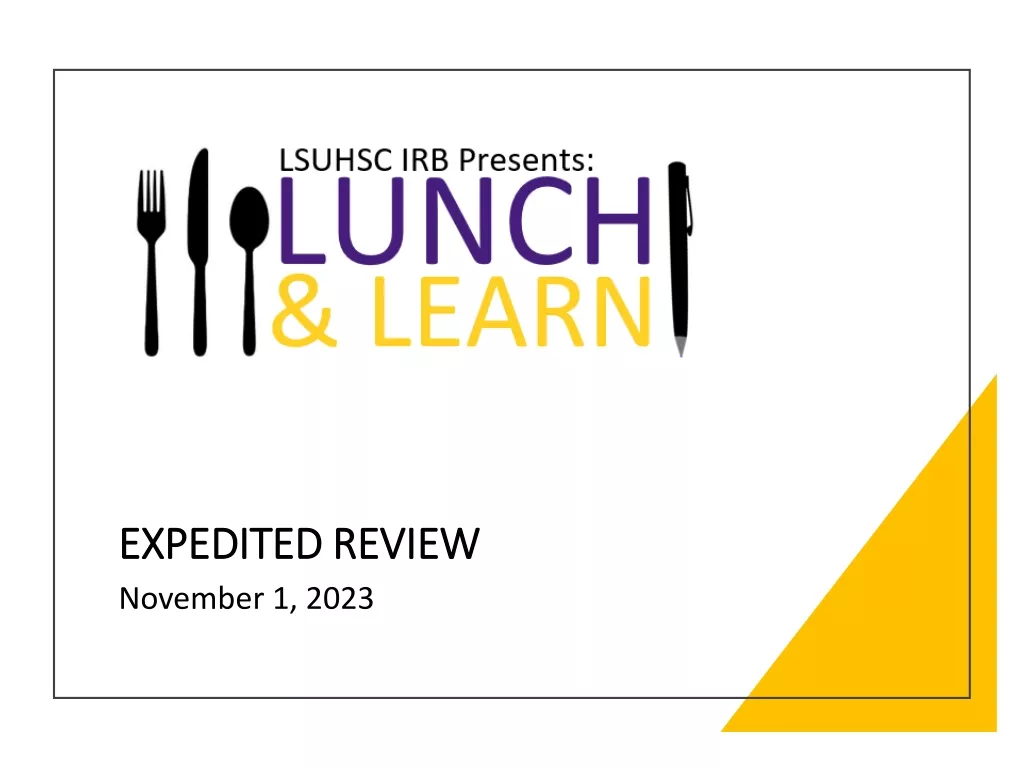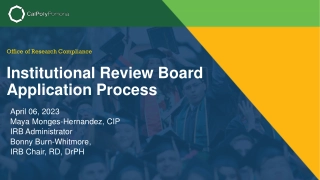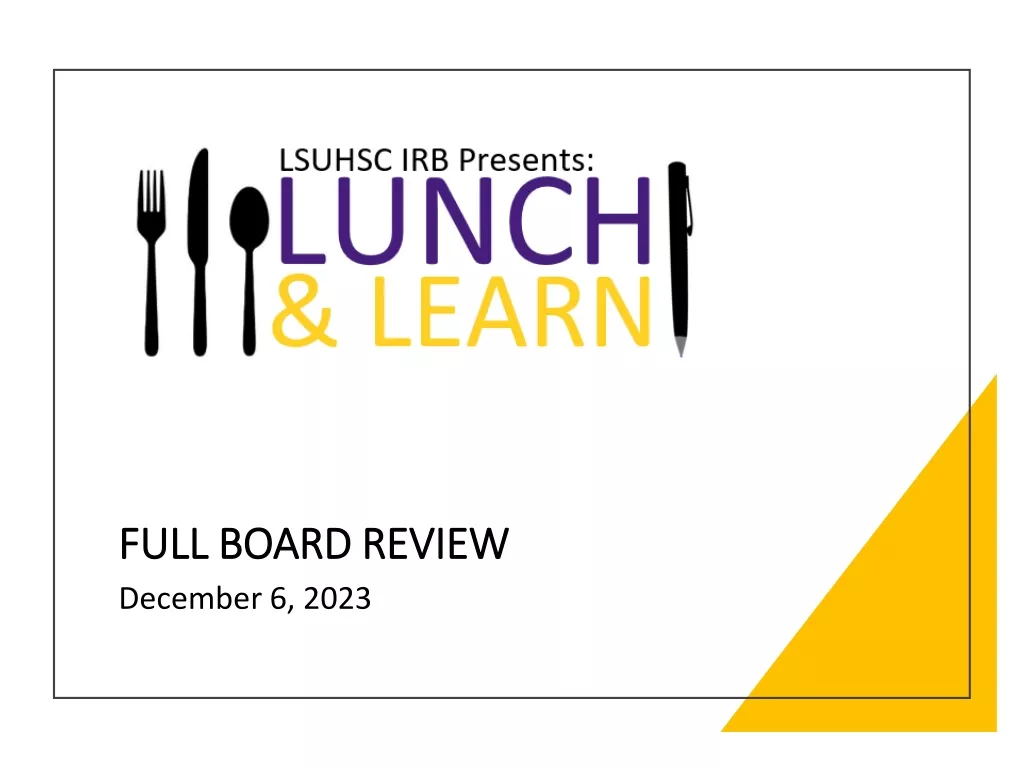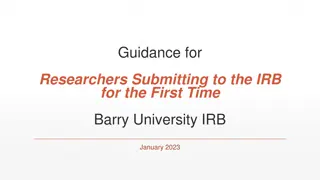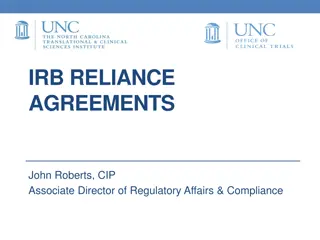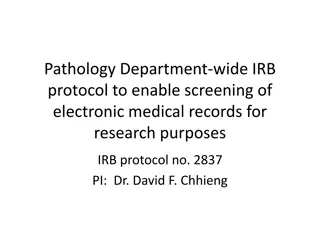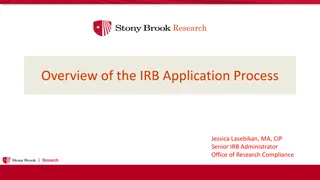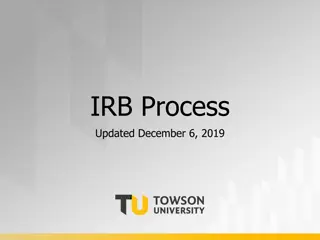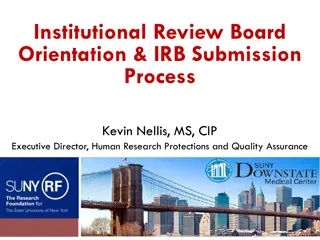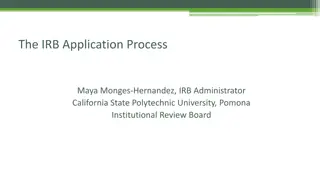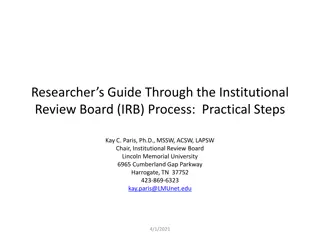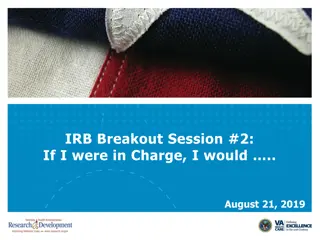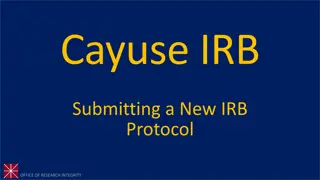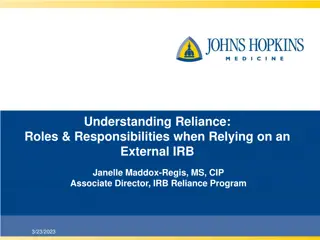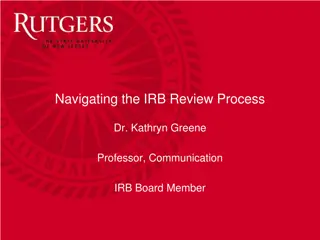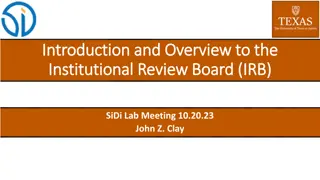Navigating the IRB for Education Research
Examine key aspects of IRB procedures in education research, including defining research boundaries, ethical considerations, types of IRB submissions, consequences of non-compliance, and international standards.
Download Presentation

Please find below an Image/Link to download the presentation.
The content on the website is provided AS IS for your information and personal use only. It may not be sold, licensed, or shared on other websites without obtaining consent from the author.If you encounter any issues during the download, it is possible that the publisher has removed the file from their server.
You are allowed to download the files provided on this website for personal or commercial use, subject to the condition that they are used lawfully. All files are the property of their respective owners.
The content on the website is provided AS IS for your information and personal use only. It may not be sold, licensed, or shared on other websites without obtaining consent from the author.
E N D
Presentation Transcript
Navigating the IRB for Education Research
Objectives Define research and human subjects research. Show the "gray area" between research and practice. Describe the distinction between a medical education initiative and a medical education research initiative. Explain the human subjects protection research regulations. List and explain the types of IRB submissions that would be appropriate for medical education research and how to go about the process. 2
I want to publish (present, etc.). so I have to submit to the IRB . Right?
Why does it matter? For research that involves human subjects, regulations require that an ethics committee (IRB) must review and approve prior to starting. Risks/benefits Informed consent Voluntary participation Assures that research is conducted according to ethical principles outlined in the Belmont Report Respect for persons Beneficence Justice DHHS Protection of Human Subjects regulations 45 CFR 46
What happens if we dont get it right? Possible harm to the patient/subject. Breach of ethical obligations to the patient/subject. Formal evaluation by OHRP and/or FDA. Determination letters /Warning letters and resulting corrective actions, enforcement actions (including debarment). OHRP holds institution responsible for conduct of its agents; FDA holds sponsor, investigator and IRB responsible. State licensing board findings/actions. Erosion of public trust in the research enterprise. 5
International Committee of Medical Journal Editors (ICMJE) and Protection of Research Participants When reporting research involving human data, authors should indicate whether the procedures followed have been assessed by the responsible review committee (institutional and national), or if no formal ethics committee is available, were in accordance with the Helsinki Declaration as revised in 2013 ..Approval by a responsible review committee does not preclude editors from forming their own judgment whether the conduct of the research was appropriate. http://www.icmje.org/recommendations/browse/roles-and- responsibilities/protection-of-research-participants.html
Examples of Indications of IRB Review in MedEd Journal Articles Enhancing motivation with the virtual supervisory role: a randomized trial (Wingo et al BMC Medical Education 2015, 15:76) The study was deemed minimal risk and exempt after Mayo Clinic IRB review. Prior to study initiation, informed consent was obtained. As part of the consent process, participants were informed that the study would compare two module formats to see if one format promotes more effective learning than the other . The first OSCE; does students experience of performing in public affect their results? (Chan, et al. BMC Medical Education 2015, 15:59) Pre-admission statements made at the time of application (UCAS personal statements) were available in individual student files. Following ethics committee approval (Project SMBRER232), these statements were coded by a researcher (MC) who was not a student or graduate of this university. This was a specific requirement of the ethics committee.
Gray Area Innovations Novel treatments/procedures Research Clinical Clinical Practice Off-label treatments/departures from SOC Non-validated practices Educational initiatives QI/QA projects Case report vs. n of 1 When a clinician departs in a significant way from standard or accepted practice, the innovation does not, in and of itself, constitute research. Belmont Report, 1979 8
Gray Area Significant innovations should be incorporated into a research project to establish safety & efficacy. RESEARCH Individual therapy Intent Generalizable Unit/program/dept. specific (i.e. QI/QA) More evidence to support goals Extent Little/less known PRACTICE
What is Research? Process of systematic inquiry or study to build knowledge in a discipline (i.e. generalizable ). Results foundation on which practice decisions and behaviors are laid. Evidence-based practice
Overview of Research Activities designed to test an hypothesis, permit conclusions to be drawn, and contribute to generalizable knowledge. Usually described in a formal protocol with an objective and set of procedures. (systematic) Treatment choices made per protocol, not necess. in the best interest of the patient/subject . ex: random assignment (systematic) Purpose is to gain knowledge, not necessarily to benefit the individual. (generalizable) Elements under study may not be of direct benefit to the subject. 11
Quality Improvement Systematic, data-guided activities designed to bring about immediate improvements in health care delivery in particular settings. Quality improvement is an intrinsic part of good clinical care, in which data from clinicians own settings guide them in improving their practices. Lynn, et. Al. Ann Intern Med. 2007;146:666-673
Is my medical education activity QI (only) or research?
QI of Med Ed program. Or Research? INTENT Is your activity designed to identify successful and unsuccessful initiatives and improve the local program only? Or, in addition to the above do you hope to provide support to change medical education beyond BMC? Are you designing this to understand what makes new educational activities better than current . Thus intending at onset to generalize? EXTENT Is your education initiative based on existing evidence from other programs? Or, are you implementing something that is it particularly novel/untried?
The distinction can be difficult.. . Efforts to contribute to generalizable knowledge in order to help future populations are often driven by curiosity as well as an initial need to solve an immediate problem . Johansson et al, Academic Medicine, vol 86, # 7, July 2011
More likely to be research.. Testing of new education practices that go beyond current knowledge informed by science and experience Randomization of learners into different intervention groups to enhance confidence in differences that might be obscured by nonrandom selection Deliberately delayed feedback of data to those monitoring the implementation of changes, especially if done to avoid biasing the interpretation of data. Involvement in key project roles of researchers who have no ongoing commitment to improvement to the local learning environment. Funding or substantial participation by parties outside the learning setting helps direct the implementation and/or evaluation protocols of the educational activity, and specific outcome data are required. Johansson et al, Academic Medicine, vol 86, # 7, July 2011
What requires IRB Review? 1) Is it research? 2) Are there human subjects? 17
Definitions Research (OHRP regs: 45 CFR 46.102 (d)) a systematic investigation, including research development, testing and evaluation, designed to develop or contribute to generalizable knowledge. Clinical Investigation (FDA regs: 21 CFR 312.3 (b)) any experiment in which a drug is administered or dispensed to, or used involving, one or more human subjects. For the purposes of this part, an experiment is any use of a drug except for the use of a marketed drug in the course of medical practice. 18
Definitions What is "generalizable knowledge"? An activity may be thought to develop or contribute to generalizable knowledge if the information collected is intended to be applied beyond a particular patient/setting/program. US Dept. Justice: http://www.ojp.usdoj.gov/funding/ decision_tree.htm Intent of the research is to add info to the field of study. Results applied beyond the subject population to other settings. Intent to test or develop scientific hypotheses, draw conclusions to be shared beyond the populations or situations being studied. BU CRC IRB
More on generalizable knowledge The knowledge contributes to a theoretical framework of an established body of knowledge. The primary beneficiaries: other researchers, scholars and practitioners in the field of study. Publication, presentation or other distribution of the results is intended to inform the field of study. The results are expected to be generalized to a larger population beyond the site of data collection. The results are intended to be replicated in other settings. Cal State Univ. San Marcos IRB
I want to publish (present, etc.). Does this mean I have to submit to the IRB? OHRP response re: publishing QI (non-research) activities: Planning to publish an account of a quality improvement project does not necessarily mean that the project fits the definition of research; people seek to publish descriptions of nonresearch activities for a variety of reasons, if they believe others may be interested in learning about those activities. Conversely, a quality improvement project may involve research even if there is no intent to publish the results. OHRP QI FAQ s http://www.hhs.gov/ohrp/policy/faq/quality-improvement-activities/index.html
Definitions Human Subject (OHRP regs: 45 CFR 46.102 (f)) a living individual about whoman investigator .. conducting research obtains: o Data through interventions or interactions with the individual, or o Identifiable private information. Subject (FDA regs: 21 CFR 312.3 (b)) a human who participates in an investigation, either as a recipient of the investigational new drug or as a control. A subject may be a healthy human or a patient with a disease. 22
Definitions Interaction/Intervention (45 CFR 46.102 (f)) physical procedures by which data are gathered manipulations of the subject or the subject s environment performed for research purposes interaction includes communication or interpersonal contact between investigator and subject 23
Definitions Private information (45 CFR 46.102 (f)) Includes information about behavior that occurs in a context in which an individual can reasonable expect that no observation or recording is taking place, and information which has been provided for specific purposes by an individual and which the individual can reasonably expect will not be made public (for example, a medical record). must be individually identifiable (i.e. the identity of the subject is or may readily be ascertained by the investigator or associated with the information) in order for obtaining the information to constitute research involving human subjects. (See also OHRP guidance on coded data/specimens: http://www.hhs.gov/ohrp/humansubjects/guidance/cdebiol.htm) 24
Determining when OHRP regs re: IRB review and informed consent apply 1) Does activity involve Research? (46.102(c)) If yes then .. 2) Does research involve Human Subjects? (46.102(f)) If yes, then . 3) Does the human subjects research meet criteria for Exempt from 45 CFR 46? (46.101(b)) Decision Trees: http://www.hhs.gov/ohrp/policy/checklists/decisioncharts.html 25
Exempt determination 45 CFR 46.101 (b)* 1. Normal educational, practices in established educational settings 2. Educational tests, surveys, interviews, or observation of public behavior unless identified & sensitive** 3. Research on elected or appointed public officials or candidates for public office 4. Research using, existing data if publicly available or recorded without identifiers (existing = at time of submission to IRB) 5. Evaluation of public benefit service programs 6. Taste and food quality evaluation and consumer acceptance studies ** does not apply to research with children except for research involving observation of public behavior when investigator(s) do not participate in the activities being observed. *None of the categories apply to Prisoner research (Subpart C). 26
Types of IRB Review Not Human Subjects Research (NHSR) NHSR means that the project does not meet the definition of human subjects research i.e. it s not research OR there are no human subjects Exempt 6 categories of exemption under the regulations Expedited Minimal risk research 7 expedited categories Convened Meeting (Full Board) Greater than minimal risk research 27
Types of IRB submissions NHSR: The educational activity is NOT research Submit to the IRB only if you need a formal determination from the IRB that it is not research. Your subsequent publication should make it clear that it is medical education practice and not research. NHSR: The educational activity IS research, but no human subjects are involved. Exempt: The medical education project IS research, but meets one of the exempt criteria under the regulations. Non-exempt (Expedited or full board): The QI project is research and does not meet exempt or NHSR criteria. Once submitted, the IRB will determine whether this is expedited for full-board. 28
IRB Submission for MedEd projects: NHSR (because there are no human subjects) or NHSR (because it s NOT research) - Educational practice only, because it s not designed to develop or contribute to generalizable knowledge - IRB submission and review/approval not required - But, in this case you want to have a formal determination from the IRB that this is medical education practice-only (not research) or there no human subjects** - (This would be a determination, not an approval) - The resulting publication should not refer to this activity as research!
INSPIR and NHSR Submission NHSR Then, make your case for WHY it is NHSR in Section 11. - What are two examples of justification that you might use?
IRB Submission for Medical Education projects: Exempt - You want to implement an educational initiative and your intent is to generalize the knowledge learned. The initiative presents minimal risk to subjects (exempt category 1). - You have implemented an evidence-based education initiative, and as part of follow-up you want to survey students and you consider this evaluation to be research (exempt category 2) - You did a medical education-only project; afterwards you decide want to generalize the results as research (exempt category 4) - IMPT: This is NOT retrospective approval for something initially intended to be research! That is NOT an option!
INSPIR and Exempt Submission Exempt In Section 11, choose Exempt category 1 if it is minimal risk education research, Exempt category 2 if you have a survey or Exempt category 4 if data is all existing at the time of submission, and it is anonymous (no link back to the record).
IRB Submission for Medical Education projects: Non-Exempt (expedited or full-board review/approval) - You want to implement a new educational practice that does not have sufficient evidence base to support its efficacy and may pose greater than minimal risk to subjects.
INSPIR and Non-exempt Submission Non-exempt Complete the full application, that builds based on your responses in Section 10. - Consider whether a waiver of consent applies; if so make that request within your application.
Flexibility in Regs re: Consent Waiving Informed Consent for Research (45 CFR 46.116 (d)) 1. Minimal Risk 2. Does not adversely affect subject rights and welfare 3. Not practicable to conduct research without the waiver 4. When appropriate, subjects provided with pertinent info after participation.
Informed Consent for Exempt (1,2) Consent form should provide the following information: that this is a research study the purpose and what the subjects are being asked to do and approximately how long it will take that participation is voluntary and if they don't want to participate it will not impact their [jobs][care] in any way that they can choose not to answer any questions that they wish how their confidentiality will be protected payments for participation if any who to contact with questions about the study (must be a member of the research team) who to contact if they have questions about their rights as a research subject -BUMC IRB at 617-638-7207 or medirb@bu.edu
Additional considerations: Risk to Subjects Two types of risk under the regulations Direct physiological or psychological harm Loss of privacy or breach of confidentiality that could place a subject at risk for social, professional, or economic consequences, or criminal or civil liabilities For example: if data collected in an experimental educational initiative is used to evaluate medical residents .. This could pose risk to subjects and be a breach confidentiality ..
Additional considerations: Vulnerability of subjects Coercion Consider power relationship between subjects (students) and investigators. Will subjects receive extra benefits to career advancement, grades, etc. due to participation? Will subjects lose benefits they would otherwise have by not participating? Undue influence
IRB application sign-offs Department chair If your application involves students or employees of the hospital you must have additional sign-off: Medical students Dean Antman Dental Students Barbara Pyke (signs off on behalf of the dean) Residents Ravin Davidoff Fellows Ravin Davidoff
Examples (time permitting) Questions???
